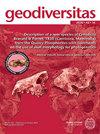Oligocene larger benthic foraminifera and sedimentation of the Burdur Basin, SW Anatolia, Turkey
IF 1.2
3区 地球科学
Q2 PALEONTOLOGY
引用次数: 0
Abstract
ABSTRACT This study focuses on the Oligocene successions that contain predominantly siliciclastic, limestones with larger benthic foraminifera in the Burdur Basin of southwest Anatolia, Turkey. The Burdur-1 and Burdur-2 sections in the Oligocene deposits are described sedimentologically and were sampled for lithology, biostratigraphy, microfacies analysis and fossil content. Larger benthic foraminifera were mainly recovered from limestones in the upper part of the Burdur-2 section. Thin-section analysis of the larger benthic foraminiferal assemblage reveals that the upper part of the Burdur-2 section includes Nummulites fichteli Michelotti, 1841, Operculina complanata (Defrance, 1822), Nephrolepidina praemarginata (Douvillé, 1908), Eulepidina sp., Planorbulina sp., Amphistegina sp., and Asterigerina sp. This foraminiferal association represents the Shallow Benthic Foraminifera Zone 22 (SBZ 22) of Rupelian-early Chattian age. Sedimentological analysis in the Burdur-1 and Burdur-2 sections has revealed an association of massive-unorganized conglomerate, parallel-bedded sandstone, massive mudstone, graded-massive conglomerate, graded-massive sandstone, well-sorted organized conglomerate, well-sorted parallel-bedded sandstone and microfossil-bearing parallel-bedded limestone facies. Alluvial fan /river, fan-delta, beach and shallow shelf carbonate facies communities were identified by lateral and vertical correlation of facies. It is concluded that the large Burdur Fan developed in a graben basin that opened and was flooded by a branch of the Tethyan Ocean that invaded southwest Anatolia during the Oligocene.土耳其安纳托利亚西南部布尔杜尔盆地渐新世大型底栖有孔虫和沉积
摘要本研究的重点是土耳其安纳托利亚西南部Burdur盆地渐新世序列,该序列主要含有硅质碎屑、灰岩和较大的底栖有孔虫。对渐新统burdur1和burdur2剖面进行了沉积学描述,并进行了岩性、生物地层学、微相分析和化石含量采样。较大的底栖有孔虫主要分布在burdur2剖面上部的灰岩中。薄层分析显示,burdur2剖面上部包括Nummulites fichteli Michelotti(1841年)、Operculina complanata (Defrance, 1822年)、Nephrolepidina praemarginata (douvill, 1908年)、Eulepidina sp.、Planorbulina sp.、Amphistegina sp.和Asterigerina sp.。该有孔虫组合代表鲁佩利—早Chattian时代浅层底栖有孔虫22带(sbz22)。通过对burdur1和burdur2剖面的沉积学分析,发现了块状-无组织砾岩、平行层状砂岩、块状泥岩、级配-块状砾岩、级配-块状砂岩、分选良好的组织砾岩、分选良好的平行层状砂岩和含微化石的平行层状灰岩相组合。通过横向和纵向对比,确定了冲积扇/河、扇三角洲、海滩和浅陆棚碳酸盐岩相群落。结论认为,大布尔都尔扇发育于渐新世特提斯洋的一个分支侵入安纳托利亚西南部后,形成并被其淹没的地堑盆地。
本文章由计算机程序翻译,如有差异,请以英文原文为准。
求助全文
约1分钟内获得全文
求助全文
来源期刊

Geodiversitas
地学-古生物学
CiteScore
3.00
自引率
5.60%
发文量
31
审稿时长
>12 weeks
期刊介绍:
Geodiversitas is a fully electronic journal, with a continuous publication stream, devoted to varied aspects of Earth Sciences. It publishes original results particularly on systematics, phylogeny, paleobiodiversity and paleoenvironment.
Thematic issues may also be published under the responsibility of a guest editor.
 求助内容:
求助内容: 应助结果提醒方式:
应助结果提醒方式:


